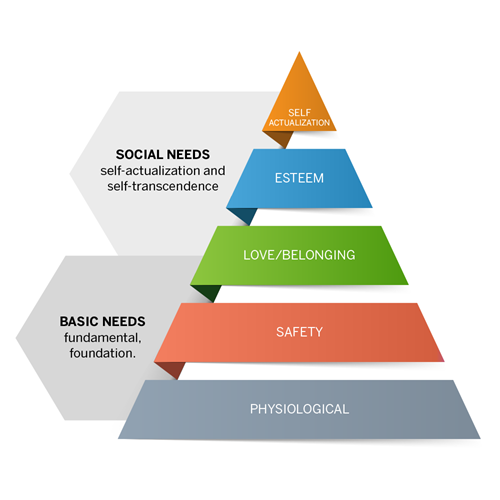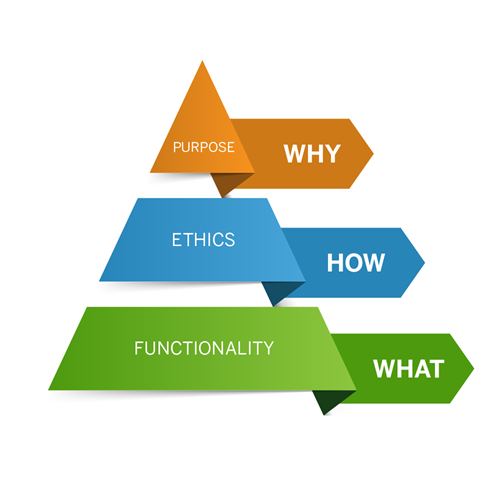
Brands in Motion: The Brand Hierarchy of Needs
I’m two weeks into a three-week tour of WE’s offices in Australia and Asia, and I’m thinking a lot about my suitcase.
Let me tell you, it’s a challenge to cram 16 presentation-ready business outfits, work gadgetry, and chargers, toiletries and makeup, rain gear (I left at the peak of typhoon season), and workout clothes into bags I can wheel into and out of hotels and airports at a moment’s notice. It changes the way you think about your packing, and because we’re launching Brands in Motion and talking about what brands need to win with consumers, I naturally started thinking about my suitcase in terms of Maslow’s hierarchy of needs:

At the base of the pyramid are fundamental needs — the physical requirements for survival. As you move up the pyramid, the needs become more complex and abstract — intimacy, self-esteem, self-actualization, etc.
Almost everything I packed falls into the lowest two tiers of the hierarchy — the basic needs. Clothes, shampoo, a raincoat. My workout gear addresses my higher-order social needs, because no matter where I am, gym time makes me feel centered, calm and more myself. I want to buy a souvenir or two to bring home for my family, but with suitcase space at a premium, it better be a very self-actualizing purchase.
Our recently released Brands in Motion global study gives us an interesting way of thinking about this hierarchy of needs: through a communications lens.
Brands in Motion aims to test our hypothesis that all brands are in motion relative to the markets in which they sit, the category they’re a part of, their competition, their employees, their investors, and current and future customers — and that this motion is either driven or inspired by technology.
We looked at brand motion through the consumer lens, by surveying more than 27,000 consumers and B2B decision-makers. A few key findings that lead us to the Brands in Motion hierarchy of consumer needs:
- Functionality is increasingly important. Many markets saw a year-over-year uptick in the percentage of respondents who wanted to support purely functional brands as opposed to purpose-led brands or brands that struck a balance between function and purpose.
- That said, purpose is a huge expectation as well. In 6 of the 8 markets we surveyed, a majority of consumers want to support a brand that strikes a balance between purpose and function.
- Almost everyone we surveyed — 97 percent of global respondents — said that it’s up to brands to regulate their own use of technology. And 94 percent said that if brands can’t do it, then governments should step in and ensure it happens.
Consumers want brands to be able to check three boxes. Functionality is foundational. It’s what the brand builds. If a brand doesn’t provide a high-functioning product or service, the vast majority of consumers won’t be interested. Ethical responsibility is a brand’s ability to adhere to legal compliance and codes of behavior in the markets in which they operate. It’s how brands do what they do while keeping their customers safe. Purpose is the framework of why a brand is doing what it’s doing. It’s intrinsic to the company itself and that organization’s values.
So with that in mind, what does a brand need to survive?

Many brands don’t hit all three points all the time, but not having all messages that speak to every level of need might make them vulnerable to disruption.
Take for example Toms, which has over-indexed on a purpose-driven message (buy a pair of shoes and they’ll give a pair of shoes), but their ethics are debatable and their shoes were never meant to be high functioning. For Toms, that’s fine — they’re not selling to the kind of person who wants a shoe that’s going to last them 30 years; they’re selling to the kind of people who want those higher order needs met, people who want to tap into the very top of the pyramid. But what happens when another brand with an equally powerful purpose message starts making better shoes?
Another example: Amazon has gone the opposite direction, and built its entire strategy around functionality. It hasn’t spent much effort on purpose or ethics messaging because it hasn’t had to. But Amazon’s reliance on third parties to provide products and assist with providing them to consumers could be its weakness. Continued reports of poor business practices could cause motion that would send the brand spinning. And what happens if brands band together and refuse to allow Amazon to carry their products?
One last example: My husband is looking to sell his car and buy something environmentally friendly. He’s not willing to flex on functionality, but he also wants to buy a car that satisfies the high-order needs he values. He’s currently considering the Prius — Toyota is a brand that builds high-functioning products that speak to a higher purpose, and is known for ethical treatment of its employees. Toyota checks all three boxes. It would take a massive scandal or complete disruption of the auto industry to destroy Toyota’s brand equity. Even if the auto industry is disrupted, Toyota is cannily shifting their branding from automotive to mobility in all its forms.
Control and lack of control
Of course, as communicators, we can understand what a brand needs to succeed, but that doesn’t always mean we can communicate effectively around that. If a brand’s business isn’t set up ethically or with purposeful leadership as a cornerstone, there’s not much we can do.
For another, we can’t control external factors. While I was visiting our Sydney office, I saw a lot of headlines about Commonwealth Bank and its money-laundering scandal. I didn’t know a thing about Commonwealth Bank, but it reminded me of similar stories in the U.S., and the Commonwealth Bank headlines fed into my general distrust of the finance industry in America. This isn’t a message a bank considering marketing to me has any control over — but it’s a message that shaped my perception of them nonetheless.
Brands have to contend with factors over which they have no control all the time. Understanding how consumer perceptions shift relative to these factors — and to the need for functionality, ethics and purpose — is key. For more on how brands can contend with a world of sky-high consumer needs and factors they can’t control, read our Brands in Motion 2018 white paper.
The latest blogs from WE
Decoding Gen Alpha: A Primer on the Next Gen of Consumers
Why Gen Alpha Will Fuel Spending This Season
Why Reputation Is a Business Driver in Healthcare

